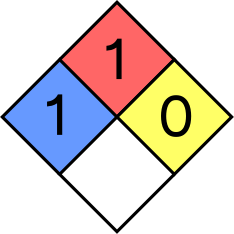BENZOPHENONE
Basic information
- Chemical formula(s): \({\rm (C_6H_5)_{2}CO}\), \({\rm Ph_2CO}\), \({\rm C_{13}H_{10}O}\)
- Other names: diphenyl ketone, benzoylbenzene, phenyl ketone, diphenylmethanone
- CAS: 119-61-9
- International Chemical Safety Card (ICSC): 0389
- Flammability: yes - requires considerable preheating
- NOAA’s description: white solid with a flowery odour; may float or sink in water
NFPA 704 (fire diamond)

- Health (blue): 1 - exposure would cause irritation with only minor residual injury.
- Flammability (red): 1 - requires considerable preheating, under all ambient temperature conditions, before ignition and combustion can occur.
- Instability–reactivity (yellow): 0 - normally stable, even under fire exposure conditions, and is not reactive with water.
- Special notice (white): -
Hazard statements
| Code | Phrase |
|---|---|
| H373 | may cause damage to organs through prolonged or repeated exposure |
| H411 | toxic to aquatic life with long lasting effects |
Precautionary statements
| Code | Phrase |
|---|---|
| P260 | do not breathe dust/fume/gas/mist/vapours/spray |
| P273 | avoid release to the environment |
| P314 | get medical advice/attention if you feel unwell |
| P391 | collect spillage |
| P501 | dispose of contents/container to HCI-Shop |
Protective measures
Gloves
Occupational Safety and Health Act of 1970 and OSHA Glove Selection Chart do not provide recommendation on gloves for handling benzophenone. Apollo Scientific provides the following recommendations:
- Neoprene: N/A
- Natural latex or rubber: N/A
- Buthyl: good at thickness greater than 0.35 mm.
- Nitrile: good at thickness greater than 0.35 mm.
Safety goggles
- Always wear safety goggles when handling benzophenone. Corrective glasses are not considered safety googles.
- Handle benzophenone inside the fume hood only (with exception of moving the closed bottle to and from the storage cabinet).
Clothing
- Wear long trousers and fully covered shoes.
- Contact lenses are forbidden while working with chemical substances, even in combination with safety glasses.
- Do not wear cosmetics.
- Do not wear synthetic clothing while working with flammable liquids or gases or when a hazard is present as these materials tend to melt and stick to exposed skin.
- Do not wear headphones.
Spill management
- Use personal protective equipment.
- Avoid dust formation, avoid breathing dust.
- Avoid breathing vapors or mist.
- Ensure adequate ventilation.
- Evacuate personnel to safe areas.
- Sweep up without creating dust and arrange disposal.
- Do not let it enter drain.
- If a spill happened outside the fume hood (on the floor or desktop) contact Dr Jakub Tkaczuk (+41 44 632 31 62) and the ETH Emergency Desk (+41 44 342 11 88 from mobile or 888 from landline).